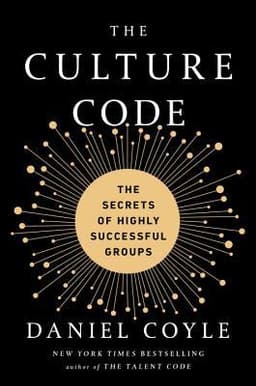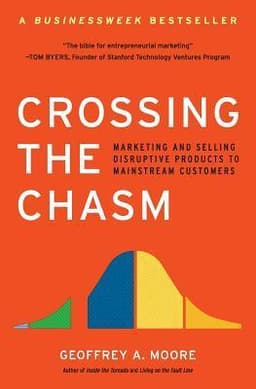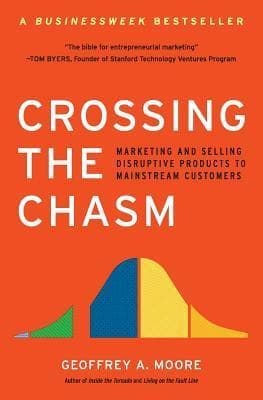
The Culture Code Book Summary
The Secrets of Highly Successful Groups
Book by Daniel Coyle
Summary
The Culture Code reveals the secrets of highly successful groups, showing that the key to unleashing a team's full potential lies in creating a culture of safety, shared vulnerability, and purpose.
Sign in to rate
Average Rating: 1
1. Build Safety
Safety Is The Foundation Of Strong Culture
The overarching insight from Chapter 1 is that psychological safety is the foundation on which all strong cultures and successful groups are built. People's brains are constantly assessing their environment and asking "Are we safe here? What's our future with these people? Are there dangers lurking?" When people feel safe and connected to others in a group, it unlocks neural pathways that enable cooperation, creativity and high performance. Conversely, when safety is absent, people become anxious, guarded and self-protective, and group performance suffers dramatically. Building safety is therefore the leader's top priority and essential for group success.
Section: 1, Chapter: 1
Belonging Cues Light Up The Brain
MIT's Human Dynamics Lab, led by Professor Alex Pentland, used sociometric badges to measure the behavioral signals exchanged in successful groups. They found that high-performing groups consistently displayed a set of subtle cues that generate feelings of belonging and safety:
- Close physical proximity (often in circles)
- Profuse amounts of eye contact
- Lots of short, energetic exchanges (no long speeches)
- High levels of mixing; everyone talks to everyone
- Few interruptions
- Intensive, active listening
- Humor, laughter
Pentland found that belonging cues were the single greatest predictor of group performance, more important than all the individual skills and intelligence of the group's members. These cues trigger the release of oxytocin and activate neural pathways of trust and cooperation, enabling the group to sync their behaviors and act as one.
Section: 1, Chapter: 1
Seek Out Belonging Cues To Create Psychological Safety
Building safety is a fluid, improvisational skill, akin to learning to pass a soccer ball to a teammate during a game. It requires you to recognize patterns, react quickly, and deliver the right signal at the right time to show your people they are valued and connected.
Displaying belonging cues (such as affirmative body language and spotlighting our own vulnerability) consistently over time will get the "static out of the way" and allow your people to do their best work together. As NYU professor Jay Van Bavel says, "A mere hint of belonging is not enough; one or two signals are not enough. We are built to require lots of signaling, over and over."
Section: 1, Chapter: 1
Mental Mountains Are Made Out Of Many Small Moments
In May 2002, an engineer at Google named Jeff Dean abandoned his own work for an entire weekend to fix a struggling side project - the AdWords engine, which was failing to match appropriate ads to search queries, jeopardizing the product's future.
Dean's fix unlocked a breakthrough that catapulted AdWords to wild success, generating billions in revenue for Google over the next few years.
The key insight is that Dean's decision didn't arise out of nowhere - it was enabled by thousands of small moments, exchanges and belonging cues that made him feel safe to take a risk. Google's early culture was rich in vulnerability, openness and connection - from Larry Page's "These ads suck" note pinned in the shared kitchen, to the frequent all-hands debates and social activities like roller hockey games.
Section: 1, Chapter: 2
Sorry About The Rain
In another study, people asking to borrow a stranger's phone were 422% more likely to get a "yes" response if they preceded their request with the words "I'm so sorry about the rain!" That one simple acknowledgement of shared experience increased compliance more than five-fold. Expressing vulnerability or invoking common ground activates the human impulse to cooperate, even between people with no existing relationship.
Section: 1, Chapter: 2
The Christmas Truce
On Christmas Eve 1914, in the midst of brutal trench warfare, German and British troops along the Western front spontaneously stopped fighting and interacted peacefully with each other, even emerging into "no man's land" to exchange gifts, share meals and play soccer together.
The Christmas Truce seems miraculous, but it actually arose from a steady buildup of small vulnerabilities and moments of connection in the preceding weeks. The physical proximity of the trenches meant the soldiers could hear each other's conversations, songs and daily routines. They developed a sense of shared identity and empathy as they realized their supposed "enemies" were not so different from themselves. Informal truces emerged around daily rituals like meals and resupply.
Section: 1, Chapter: 3
From 50% Attrition To 250% Retention
WIPRO, a successful Indian call center, was facing a costly problem - 50-70% of its employees quit within a year of being hired. Traditional incentives and perks had no impact on retention. So WIPRO ran an experiment - they divided new hires into three groups:
- Group 1 heard stories about WIPRO's accomplishments and star performers. At the end they received a fleece sweatshirt with the WIPRO logo.
- Group 2 was asked to share their own strengths, proud moments, and times they had made a difference. At the end they received a fleece sweatshirt with their name and WIPRO's logo.
- Control group went through the normal orientation with no extra session.
The results were stunning - Group 2 had a 250% higher retention rate than Group 1 and 157% higher than the control group. By investing one hour to make people feel personally recognized and valued, with specific reflections on their own potential, WIPRO was able to massively boost their emotional commitment to the organization.
Section: 1, Chapter: 3
The First Follower Transforms A Lone Nut Into A Leader
The "first follower" principle has many applications, but a key one is to build psychological safety on your team:
- When someone shares a dissenting opinion or crazy idea in a meeting, publicly thank them and engage with their view, even (especially) if you disagree. Doing so will encourage others to voice unorthodox thoughts as well.
- If a team member admits a mistake or failure, appreciate their honesty and vulnerability. Demonstrating that it's safe to take interpersonal risks will inspire others to do the same.
- When you notice someone going out of their way to support or include others, shine a spotlight on their actions so it becomes a model for the group.
Section: 1, Chapter: 3
Embrace The Discomfort
One of the hardest parts of building a cohesive culture is learning to tolerate the discomfort, inefficiency and messiness of open, honest conversations. Giving and receiving real-time candid feedback, admitting mistakes, confronting conflicts, and reflecting on tough challenges is awkward and painful.
But the leaders in this book emphasize that you have to push through that resistance. The pain isn't a problem but a sign of progress. You will realize that the hard, scary conversations are the real work of building a great team. Some ways to embrace the productive discomfort:
- Institute regular AARs (after-action reviews) to reflect on successes and failures
- Hold open forums where people can ask leaders anything, no matter how sensitive
- Practice sharing unfinished, imperfect work to get feedback from peers
- When conflicts arise, resist the urge to smooth things over; support the team to confront the tensions head-on
Section: 1, Chapter: 4
The Allen Curve
In the 1970s, MIT professor Thomas Allen set out to discover why some engineering teams were more productive and innovative than others. What he found - the best predictor of team success was not skill level, resources, or experience, but simple physical proximity.
- When people sit within 8 meters of each other, communication and collaboration skyrocket, with an exponential increase the closer you get
This pattern is known as the Allen Curve. It reveals the huge impact of proximity on behavior and output. The simple act of being able to see and talk to people in an instant, without barriers or formality, is an incredible accelerator of trust and creative problem-solving. To apply this principle:
- Organize your physical space around an open central area that enables "collisions" between people
- Designate team spaces for informal hangouts (couches, snacks, games, etc.)
- Reduce private offices and increase shared spaces
Section: 1, Chapter: 5
Make The Leader Occasionally Disappear
Several leaders use a surprising tactic to build their team's self-sufficiency and problem-solving skills - they make themselves scarce at key moments. By leaving a strategic void, they create space for the team to step up and take charge of their own learning and performance.
- Gregg Popovich regularly huddles with his assistant coaches during timeouts but occasionally skips the player huddle, leaving them to figure things out
- The New Zealand All-Blacks rugby team has a standing policy that the coaches cannot attend the first 15 minutes of any practice; the players are expected to warm up and set the tone on their own
In each case, the leader's absence is not an abdication but a challenge and an opportunity. It sends the message, "You are capable of doing this yourselves, and I trust you to rise to the occasion."
The key is for the leader to scaffold these "missing leader" moments carefully - they work best when the team has a foundation of trust and shared purpose to build on.
Section: 1, Chapter: 6
Listen Like You're An Improv Actor
In improv comedy, one of the cardinal rules is "yes, and" - when your partner initiates an idea, you're obligated to affirm and build on it vs. ignoring or contradicting it. The most skilful improvisers are relentless in their focus on hearing the offer behind their partner's words and actions. Instead of planning their own agenda, they tune into the other person and allow the conversation to emerge organically.
Section: 1, Chapter: 6
2. Share Vulnerability
Intellectual Humility
The most effective problem-solving groups share a common trait - they prioritize intellectual humility over individual status or ego. Intellectual humility is the willingness to admit what you don't know, to welcome new and contradictory ideas, and to change your mind in the face of compelling logic or evidence. To model intellectual humility as a leader:
- Frame questions neutrally: "What am I missing?" vs. "Does anyone disagree with my idea?"
- Give people permission to challenge your thinking: "I could be wrong, so tell me if you see it differently"
- When someone raises a contrary view, thank them for it: "I'm so glad you brought that up; it made me rethink my assumptions"
- Call out groupthink: "I'm worried we're getting too bought into this plan - who can poke holes in it?"
- Reward people not just for being right, but for successfully changing the group's mind
Section: 2, Chapter: 7
The 5:1 Positivity Ratio
Psychologist John Gottman has studied the communication patterns of married couples and found that the most satisfied and stable couples maintain a "positivity ratio" of about 5:1 in their interactions - that is, they exchange five positive signals (smiles, compliments, jokes, friendly touches) for every one negative signal (criticism, sarcasm, contempt).
Gottman's insight can be applied to any team or relationship:
- Track your own positivity ratio in conversations; make an effort toverbally and nonverbally "catch people doing something right" vs. only commenting on mistakes
- Start sensitive conversations and tough feedback with a sincere, specific positive (behavior, not trait): "I really appreciated how thoroughly you prepared for that meeting; here's one thing I think you could improve for next time..."
- Do regular check-ins to surface and resolve small annoyances before they fester; the goal is to maintain trust and good faith even when disagreeing
Section: 2, Chapter: 8
The Vulnerability Leap
"Vulnerability doesn't come after trust - it precedes it. Leaping into the unknown, when done alongside others, causes the solid ground of trust to materialize beneath our feet."
Section: 2, Chapter: 8
Red Balloons And Red Faces
In 2009, DARPA launched the Network Challenge, a nationwide hunt to find ten red weather balloons that had been secretly placed in various locations. The winning team would receive $40,000. The contest featured two very different collaboration strategies:
- Most teams used a "hub and spoke" model where a central authority directed the search and offered to share the prize money with anyone who provided useful information. This approach created a lot of activity and competition, but also a lot of noise and inefficiency.
- The winning team, from MIT, used a "cascading incentive" model where anyone who contributed to finding a balloon (directly or indirectly) would share in the reward. This approach essentially turned every participant into a recruiter and problem-solver; the network grew organically as people invited their friends and family to join.
The MIT team's decentralized, non-hierarchical strategy was incredibly effective - they located all ten balloons in under nine hours, shocking the challenge organizers who had expected it to take days or weeks. The key was that every participant had skin in the game and could take initiative without waiting for orders or permission.
Section: 2, Chapter: 8
Intellectual Humility In The Cockpit
In the 1970s, a series of high-profile plane crashes revealed a disturbing pattern - in many cases, the crash was caused not by mechanical failure or bad weather, but by human error and dysfunction in the cockpit. To address this issue, the NTSB (National Transportation Safety Board) developed a new training protocol called CRM (Crew Resource Management). CRM was designed to break down the communication barriers between pilots and crew:
- Captains were taught to proactively invite input and feedback from their crew, especially in high-stress situations. They practiced using inclusive language like "What do you think?".
- Crews were given explicit permission to challenge the captain's decisions if they had safety concerns. They practiced using assertive language like "I'm not comfortable with that" and "I suggest we consider another option."
- Debriefs focused not just on technical skills but on communication and decision-making processes. Crews were rewarded for admitting mistakes and identifying areas for improvement.
CRM represented a radical shift in mindset for an industry built on strict obedience to authority. It wasn't easy or comfortable for pilots and crews to adopt, but the airline industry's safety record has improved dramatically, with human error accounting for a much smaller share of accidents and incidents.
Section: 2, Chapter: 10
Listen Like A Trampoline
According to research by Jack Zenger and Joseph Folkman, the most effective listeners don't just absorb information - they engage in a dynamic back-and-forth that elevates the conversation. Specifically, they do four things:
- They make the other person feel safe and supported to share their full truth, without fear of judgment or interruption.
- They ask questions that challenge old assumptions and invite new perspectives.
- They make occasional suggestions that build on the other person's ideas and point in new directions.
- They reflect back what they're hearing toThey reflect back what they're hearing to check for understanding and reinforce key points.
In other words, great listeners are like trampolines - they provide a solid, reliable foundation that allows others to take risks and reach new heights. They add energy to the conversation without stealing the spotlight. They know when to be springy and when to be still, when to push and when to hold steady.
Section: 2, Chapter: 11
Turn Anxiety Into Motivation
Imagine you're about to have a difficult conversation with a colleague who has been underperforming. As the meeting approaches, your anxiety builds until you're physically tense and mentally churning. Now imagine naming this anxiety out loud to your colleague at the start of the meeting.
What effect might this preface have on the conversation? Research suggests it could be transformative:
- By acknowledging your own anxiety, you create permission for your colleague to do the same, normalizing vulnerability and creating psychological safety.
- By framing the conversation as a shared challenge, you invite your colleague to be part of the solution rather than a target of criticism.
- By expressing your commitment to the relationship, you reduce the threat of the feedback and increase motivation to change.
Naming anxiety is a simple but powerful way to break the ice and short-circuit defensive routines in any high-stakes interaction.
Section: 2, Chapter: 12
The Perfect Feedback Formula
Giving feedback is one of the most important skills for any leader, but it's also one of the most dreaded and mishandled. Here's a simple formula for delivering feedback that is clear, specific, actionable, and motivating:
- Describe the behavior or situation objectively, without judgment or interpretation.
- Explain the impact of the behavior on you, the team, or the work product.
- Ask for the person's perspective and listen actively. Ex: "I'm curious to hear your take on what happened. What was going through your mind at that moment?"
- Reaffirm your commitment to the person's success and growth.
- Agree on a specific, measurable action to try going forward.
Ex: "In our next meeting, let's pay attention to how much airtime each person gets and make sure everyone has a chance to finish their thoughts"
Section: 2, Chapter: 12
3. Establish Purpose
Three Hundred and Eleven Words
In 1982, Johnson & Johnson faced a devastating crisis when seven people died after taking cyanide-laced Tylenol capsules. In the midst of this chaos, J&J's leaders turned to the company's credo - a 311-word statement of purpose that outlined its responsibilities to customers, employees, communities, and shareholders, in that order.
Throughout the crisis, J&J's leaders referenced the credo in every meeting and decision. It gave them clarity and conviction in the face of immense pressure and uncertainty. By putting customer safety first, even at great financial risk, they lived up to the purpose and values that defined the company.
Section: 3, Chapter: 13
Mental Contrasting
Psychologist Gabriele Oettingen has discovered a simple but powerful technique for boosting motivation and follow-through on any goal or behavior change. She calls it mental contrasting, and it involves two steps:
- Vividly imagine the positive future you want to achieve - the best-case scenario, the ideal outcome. Let yourself feel the emotions and benefits associated with realizing this vision.
- Confront the obstacles and challenges that stand in the way of that future - the roadblocks, the setbacks, the inner resistance. Be brutally honest about what could derail you or hold you back.
The magic of mental contrasting is that it connects the present to the future in a way that sparks action and persistence. By juxtaposing the desired state with the current reality, it creates a sense of urgency and purpose - a feeling of "I want this, and here's what I need to do to get it."
Section: 3, Chapter: 13
Designing The Environment To Change Behavior
In the early 2000s, Portuguese police were bracing for an invasion of English soccer hooligans during the European Championships. Desperate for a new approach, the Portuguese authorities turned to Clifford Stott, a social psychologist who studies crowd dynamics. Stott's insight was that the hooligans were not inherently violent, but responding to cues in their environment that made them feel threatened and aggressive, so:
- Instead of riot gear, officers wore bright yellow vests and were trained to be friendly, approachable, and focused on de-escalation.
- Instead of randomly stopping and searching fans, officers engaged them in positive conversations about the teams and the tournament.
- Officers were given discretion to manage minor infractions (e.g. public drinking) with a light touch, focusing on building rapport vs. making arrests.
This story illustrates the power of what psychologists call "situational leadership" - the idea that the best way to influence behavior is often not to try to change people directly, but to change the situations and environments they find themselves in.
Section: 3, Chapter: 14
The Power Of Heuristics In Complex Environments
Danny Meyer is the CEO of Union Square Hospitality Group, which owns and operates some of the most acclaimed restaurants in New York City. How does Meyer ensure that his teams are always on their game, no matter what challenges they face?
The answer lies in what cognitive scientists call heuristics - simple, memorable rules of thumb that guide behavior in complex situations. Heuristics make it easy for his employees to do the right thing, even under pressure. Some examples:
- "The Excellence Reflex": Treat every customer interaction, no matter how small, as an opportunity to create a memorable experience.
- "Athletic Hospitality": Anticipate customers' needs before they ask, and go the extra mile to exceed their expectations.
- "The 51% Solution": If a customer is unhappy with their experience, it's the restaurant's responsibility to make it right, even if the customer is partly to blame.
- "Writing a Great Last Chapter": The last few minutes of an interaction are disproportionately important in shaping a customer's overall impression and likelihood to return.
Section: 3, Chapter: 15
"Fail Early, Fail Often" - Pixar's Secret Weapon
Ed Catmull, co-founder and former president of Pixar Animation Studios, is no stranger to failure. Catmull estimates that only about 1 in 100 ideas that are pitched at Pixar actually make it to the screen - and even then, they go through countless iterations and revisions along the way.
But rather than seeing these "failures" as setbacks or wastes of time, Catmull and his team see them as invaluable opportunities for learning and growth, and developed a number of practices:
- Daily reviews where work in progress is shared and critiqued by the entire studio
- "Plussing" sessions where people build on each other's ideas rather than tearing them down
- Regular "Braintrust" meetings where a small group of trusted advisors give candid, constructive feedback on a project at key milestones
- Postmortems after each film to capture lessons learned and identify areas for improvement
The goal of these practices is not to eliminate failure, but to make it safe and productive, by creating an environment where people feel comfortable taking risks and learning from their mistakes.
Section: 3, Chapter: 16
Leading With Purpose In A Crisis
Purpose is a strategic asset that guides actions and decisions in the face of uncertainty. To harness its power, leaders must regularly revisit and recommit to purpose, connect people's work to the larger mission, celebrate purpose-driven behaviors, and empower judgment calls that serve the greater good. Embodying purpose in a crisis can make the difference between a team that fractures or emerges stronger.
Section: 3, Chapter: 17
Related Content


Crossing the Chasm Book Summary
Geoffrey Moore
"Crossing the Chasm" unveils the hidden challenges of launching disruptive technologies and provides a proven roadmap for navigating the treacherous gap between early adopters and mainstream markets, enabling companies to achieve market leadership and sustainable growth.
"Crossing the Chasm" unveils the hidden challenges of launching disruptive technologies and provides a proven roadmap for navigating the treacherous gap between early adopters and mainstream markets, enabling companies to achieve market leadership and sustainable growth.
Business
Management
Technology


Think Again Book Summary
Adam Grant
Think Again is a compelling exploration of the power of knowing what you don't know, and how embracing the joy of being wrong and actively questioning your opinions can help you make better decisions
Think Again is a compelling exploration of the power of knowing what you don't know, and how embracing the joy of being wrong and actively questioning your opinions can help you make better decisions
Psychology
Business
Personal Development

